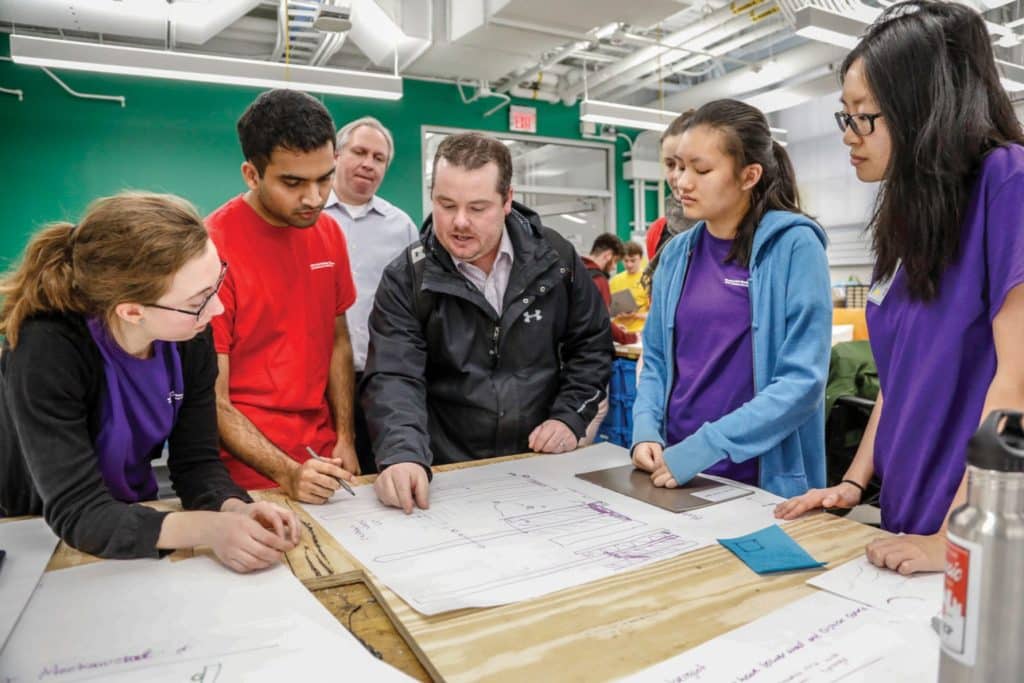Unexpected collaborations can have wide-ranging impacts. The recent partnership between the Pittsburgh Penguins and Covestro LLC is just one example. The two organizations are teaming up to explore how advanced materials might be applied to improve the safety and sustainability of hockey.
The partnership emerged from an existing friendship between Penguins president and CEO David Morehouse and Covestro’s chairman and CEO in North America, Jerry MacCleary. At a Penguins’ game in 2017, the two discussed possible ways that Covestro’s advanced materials might be incorporated into hockey rink and equipment designs to improve the safety of the sport, not just at the professional level, but for youth and peewee leagues as well. Bob Walker, head of External Communications for Covestro LLC, was assigned the project, and charged with bringing together the R&D groups within the company to come up with a potential solution.
Walker’s first step was to speak to his counterparts in Germany, where Covestro AG has been a premium partner of the German Ice Hockey League since 2016. These discussions led to the proposal of a “make-a-thon,” a process that has been used by the company multiple times in various parts of the world in which a problem is attacked through collaboration with a local university. During these intense five-day workshops, university students work with Covestro material experts to develop practical solutions that the company can then carry forward. The proposal was well received by the Penguins, who suggested Carnegie Mellon University (CMU) as the ideal partner because the team was already working with the school in other areas. Members of the College of Engineering at CMU were equally enthusiastic.
The theme for the project—“Rethink the Rink”—encompasses the goal to develop material solutions that enhance the safety of hockey without compromising game performance. Twenty-two CMU students worked with experts from the Penguins and Covestro LLC during the make-a-thon. During the first day, the problem was defined, representatives from the Penguins discussed equipment and rink design, and the team doctor talked about the nature of the injuries he treats. The scope of the project was narrowed down to improving the rink dasher board and glass system, because the majority of injuries occur when players hit the boards. “Players are bigger, faster, and stronger than ever before, and so our challenge is to find new ways to keep them safer and reduce injuries,” Morehouse says. “This collaboration with Covestro and Carnegie Mellon is a specific attempt to use recent advances in material science to address the physical boundary that surrounds a hockey rink. Can we come up with a material solution that reduces the impact of players hitting the boards and makes the game safer for players of all ages?” he asks.
The students were then broken into five teams and were given time to brainstorm solutions with coaching from experts in polyurethane and polycarbonate technologies from Covestro and rink experts from the Penguins. On the fifth day, the students presented their ideas to six judges (two from each organization) at an event held at the Penguins’ practice facility.
“Many very good ideas were generated by each of the teams during the make-a-thon that we determined were worth pursuing. Approximately two weeks after the make-a-thon was completed, we brought the students back for one more brain-storming session to coalesce the best ideas from each team into a single path forward,” says Walker. “Currently, our technical experts are working with two CMU students to develop a prototype dasher board. The design will be submitted to experts at the NHL and USA Hockey for feedback with the intention of installing actual boards at the Penguins’ practice facility by September or October for actual testing.”
“I cannot imagine better partners than Covestro and Carnegie Mellon Engineering, acknowledged global engines of innovation in materials and engineering,” Morehouse remarks. “Combined with insight from the Penguins and the NHL on the hockey and rink management side, we think it is an exceptional team to explore ways to make an inherently physical sport safer for all players. This can be a meaningful research project that, if we achieve our goal, could help make a long-term impact on the game.”
The dasher boards are just the first step in the process. While in the past Covestro was a sponsor of the Penguins, the company today is now the official Innovation Partner of the team and has established a formal, multi-year collaboration. “The goal through projects like the ‘Rethink the Rink’ program is to substantiate what being an innovation partner really means through the development of solutions that improve the safety of hockey—not just for the Penguins, but for players of all ages and skill levels,” Walker notes. There are many aspects of the equipment, from the helmets to the sticks to the pucks, that can be explored in the coming years. “The partnership between a championship hockey team and a global company focused on high-tech materials creates a unique environment for innovation,” adds Morehouse. MacCleary is excited about the partnership, not only because it supports Covestro’s strong focus on innovation and sustainability, but also because it represents the unconventional kind of collaboration that is characteristic of Pittsburgh.
The materials being incorporated into the dasher board prototype include rigid and flexible polyurethane foams, thermoplastic polyurethanes, and polycarbonate. While coatings have not yet been examined, Walker believes there will be coating applications, particularly for the polycarbonate components, that will be developed as the project proceeds through the summer.
